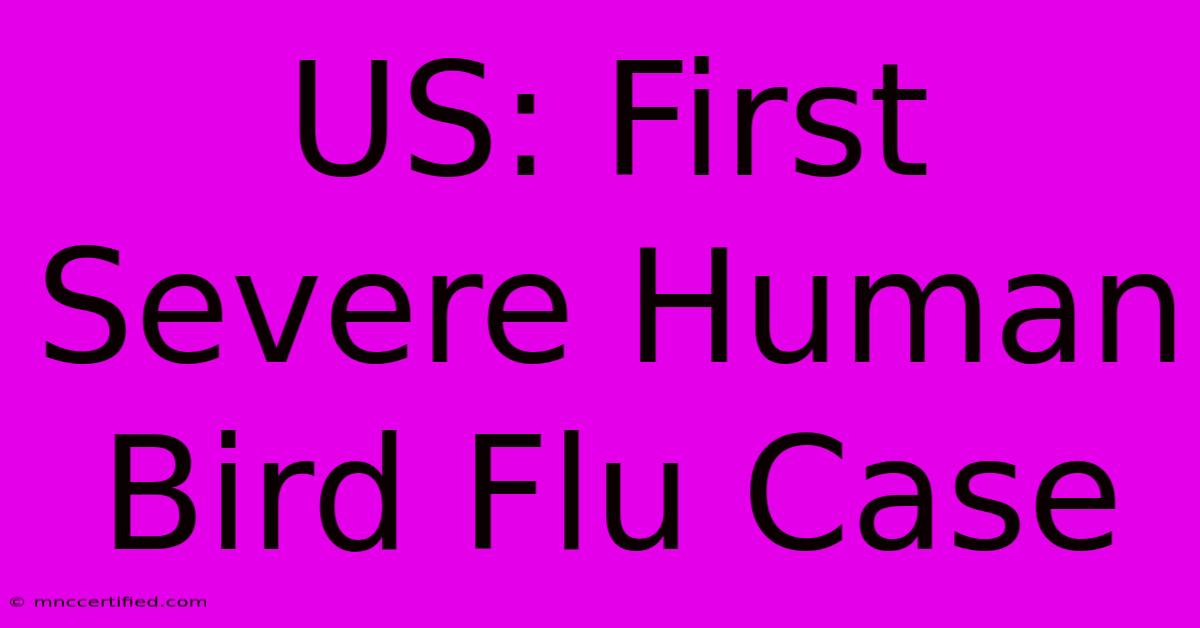US: First Severe Human Bird Flu Case

Table of Contents
US: First Severe Human Bird Flu Case – A Public Health Concern
The United States recently confirmed its first severe human case of avian influenza A(H5N1), sparking concerns about the potential for wider spread and underscoring the importance of public health vigilance. This case highlights the ongoing threat posed by avian influenza and the need for continued monitoring and preventative measures.
Understanding the Severity of the Situation
While human infections with avian influenza are relatively rare, this case stands out due to its severity. Unlike many previous infections which presented with mild symptoms, this individual experienced a serious illness, requiring hospitalization and intensive medical care. This underscores the potential danger of certain strains of avian influenza and the need for rapid detection and treatment. The exact details of the patient's condition, including their age and location, are typically withheld to protect their privacy, in accordance with HIPAA regulations. However, the severity of the illness serves as a stark reminder of the potential risks associated with avian influenza.
Transmission and Risk Factors
Avian influenza primarily spreads through direct contact with infected birds or their droppings. However, human-to-human transmission is rare, though not impossible. The current understanding is that this particular case did not involve human-to-human transmission, meaning the individual likely contracted the virus through direct or indirect contact with infected birds. Risk factors include close contact with poultry, live bird markets, or contaminated environments. While the risk to the general public remains low, individuals working with poultry or those who frequently handle birds should take extra precautions.
Public Health Response and Prevention
The Centers for Disease Control and Prevention (CDC) and other public health agencies are closely monitoring the situation and implementing measures to prevent further spread. This includes:
- Enhanced surveillance: Increased monitoring of avian influenza in poultry and wildlife populations to detect outbreaks early.
- Improved diagnostics: Quick and accurate testing for avian influenza in humans to ensure prompt diagnosis and treatment.
- Public health messaging: Dissemination of information to educate the public about avian influenza, risk factors, and preventive measures.
- International collaboration: Working with global health organizations to share information and coordinate efforts to control avian influenza outbreaks.
Protective Measures You Can Take
While the risk to the general public is low, there are several steps you can take to protect yourself:
- Avoid contact with wild birds: Do not touch or handle sick or dead birds.
- Practice good hygiene: Frequently wash your hands with soap and water, especially after handling poultry or birds.
- Cook poultry thoroughly: Ensure that poultry is cooked to an internal temperature of 165°F (74°C) to kill any potential viruses.
- Stay informed: Stay up-to-date on the latest information from the CDC and other reliable sources.
The Importance of Ongoing Monitoring and Research
The emergence of this severe human case of avian influenza highlights the importance of continued monitoring, research, and public health preparedness. Further research is needed to fully understand the potential for human-to-human transmission and the factors contributing to severe illness. Investing in antiviral drug development and vaccine research is crucial to ensure we have effective tools to combat future outbreaks. International collaboration and data sharing remain essential in mitigating the global threat posed by avian influenza.
This situation underscores the dynamic nature of infectious diseases and the need for ongoing vigilance. While the risk to the general public remains low, this case serves as a critical reminder of the importance of public health preparedness and the potential consequences of neglecting avian influenza prevention measures.

Thank you for visiting our website wich cover about US: First Severe Human Bird Flu Case. We hope the information provided has been useful to you. Feel free to contact us if you have any questions or need further assistance. See you next time and dont miss to bookmark.
Featured Posts
-
Tate Assets Seized 2 Million
Dec 19, 2024
-
Dow Plunges 1123 Fed Impact
Dec 19, 2024
-
Delevingnes Elton John Transformation
Dec 19, 2024
-
Who Is Matilda Djerf Recent Apology
Dec 19, 2024
-
Two Californians Close To 760 M
Dec 19, 2024